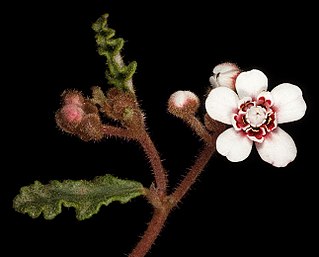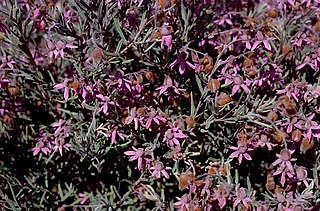
Thomasia sarotes is a species of flowering plant in the family Malvaceae. It is an upright, spreading shrub with purple, pink to mauve or white flowers and is endemic to the south-west of Western Australia.

Lysiosepalum involucratum is a species of flowering plant in the family Malvaceae and is endemic to the south-west of Western Australia. It is dense, compact or spreading shrub with its young branches covered with woolly, star-shaped hairs, and has narrowly egg-shaped leaves and purple flowers usually in groups of 2 to 6.

Phebalium lepidotum is a species of rounded shrub that is endemic to Western Australia. It has scaly branchlets, leathery, narrow oblong leaves and white to cream-coloured flowers arranged in umbels of between three and six on the ends of branchlets.
Phebalium microphyllum is a species of small, rounded shrub that is endemic to Western Australia. It has scaly branchlets, leathery, oblong leaves, and yellow flowers arranged in umbels of three to six on the ends of branchlets.

Androcalva pulchella is a species of flowering plant in the family Malvaceae and is endemic to the south-west of Western Australia. It is a small shrub with egg-shaped, elliptic or oblong leaves, the edges wavy, lobed or toothed, and clusters of two to seven white and deep pink flowers.

Lasiopetalum quinquenervium is a species of flowering plant in the family Malvaceae and is endemic to the south of Western Australia. It is an erect, spreading shrub with hairy stems and leaves, egg-shaped leaves and pink or white flowers.

Spyridium cordatum is a species of flowering plant in the family Rhamnaceae and is endemic to the south-west of Western Australia. It is a prostrate, straggling or ascending shrub with leathery, broadly heart-shaped leaves with a notched tip, 2–4 mm (0.079–0.157 in) long with woolly, white or rust-coloured hairs on the lower side. The heads of flowers are 6.5–8.5 mm (0.26–0.33 in) wide with two to four floral leaves at the base. The sepals are up to 1.6 mm (0.063 in) long the petal tube shaggy-hairy with more or less glabrous lobes.

Spyridium microcephalum is a species of flowering plant in the family Rhamnaceae and is endemic to the south-west of Western Australia. It is a spreading or erect shrub with linear leaves and heads of woolly-hairy flowers.
Pimelea drummondii is a species of flowering plant in the family Thymelaeaceae and is endemic to near-coastal areas of southern Western Australia. It is an erect, slender shrub with narrowly elliptic or elliptic leaves arranged in opposite pairs, and white or cream-coloured flowers surrounded by 3 or 4 pairs of pale green to yellowish involucral bracts.

Thomasia brachystachys is a species of flowering plant in the family Malvaceae and is endemic to the Southwest Australia south-west of Western Australia. It is an open, erect shrub with egg-shaped to heart-shaped leaves and pink to mauve flowers.
Spyridium villosum is a species of flowering plant in the family Rhamnaceae and is endemic to the south-west of Western Australia. It is a small shrub with shaggy-hairy branchlets, linear to oblong leaves and dense heads of hairy flowers with broad brown bracts at the base.

Thomasia rhynchocarpa is a species of flowering plant in the family Malvaceae and is endemic to the Southwest Australia south-west of Western Australia. It is an erect, slender shrub with narrowly egg-shaped leaves with a heart-shaped base, and pink to purple flowers.

Thomasia rugosa, commonly known as wrinkled leaf thomasia, is a species of flowering plant in the family Malvaceae and is endemic to the south-west of Western Australia. It has wrinkled, lance-shaped to egg-shaped leaves with wavy edges, and pink to mauve flowers.

Thomasia stelligera is a species of flowering plant in the family Malvaceae and is endemic to the south-west of Western Australia. It is a low, spreading shrub with scattered, narrowly oblong leaves, and racemes of mauve flowers.
Androcalva cuneata is a species of flowering plant in the family Malvaceae and is endemic to the south-west of Western Australia. It is a low, spreading, densely hairy shrub that sometimes forms suckers and has wedge-shaped leaves and clusters of 5 to 15 pink flowers.

Commersonia densiflora is a species of flowering plant in the family Malvaceae and endemic to the south-west of Western Australia. It is a dense, low-growing shrub with pinnate, elliptic to narrowly oblong, prominently veined leaves, and white flowers in clusters of 100 or more.
Commersonia rotundifolia, commonly known as round-leaved rulingia, is a species of flowering plant in the family Malvaceae and endemic to the south-west of Western Australia. It is an upright, openly-branched shrub with elliptic to round leaves with wavy edges, and white flowers in clusters of 3 to 10.

Androcalva crispa, commonly known as crisped leaf commersonia, is a species of flowering plant in the family Malvaceae and is endemic to the south-west of Western Australia. It is a prostrate shrub that forms suckers from rhizomes and has densely new growth, clusters of lobed, egg-shaped or oblong leaves with wavy, serrated edges, and groups of white and pinkish-purple flowers.

Guichenotia angustifolia is a species of flowering plant in the family Malvaceae and is endemic to the south-west of Western Australia. It is an erect, prostrate or climbing shrub with hairy young growth, hairy, oblong to linear leaves and pink to mauve flowers.
Marianthus microphyllus is a species of flowering plant in the family Pittosporaceae and is endemic to the south of Western Australia. It is a small, erect, spreading shrub with clustered, funnel-shaped, stem-clasping leaves and deep blue to almost purple flowers that darken as they age, arranged singly in leaf axils.















